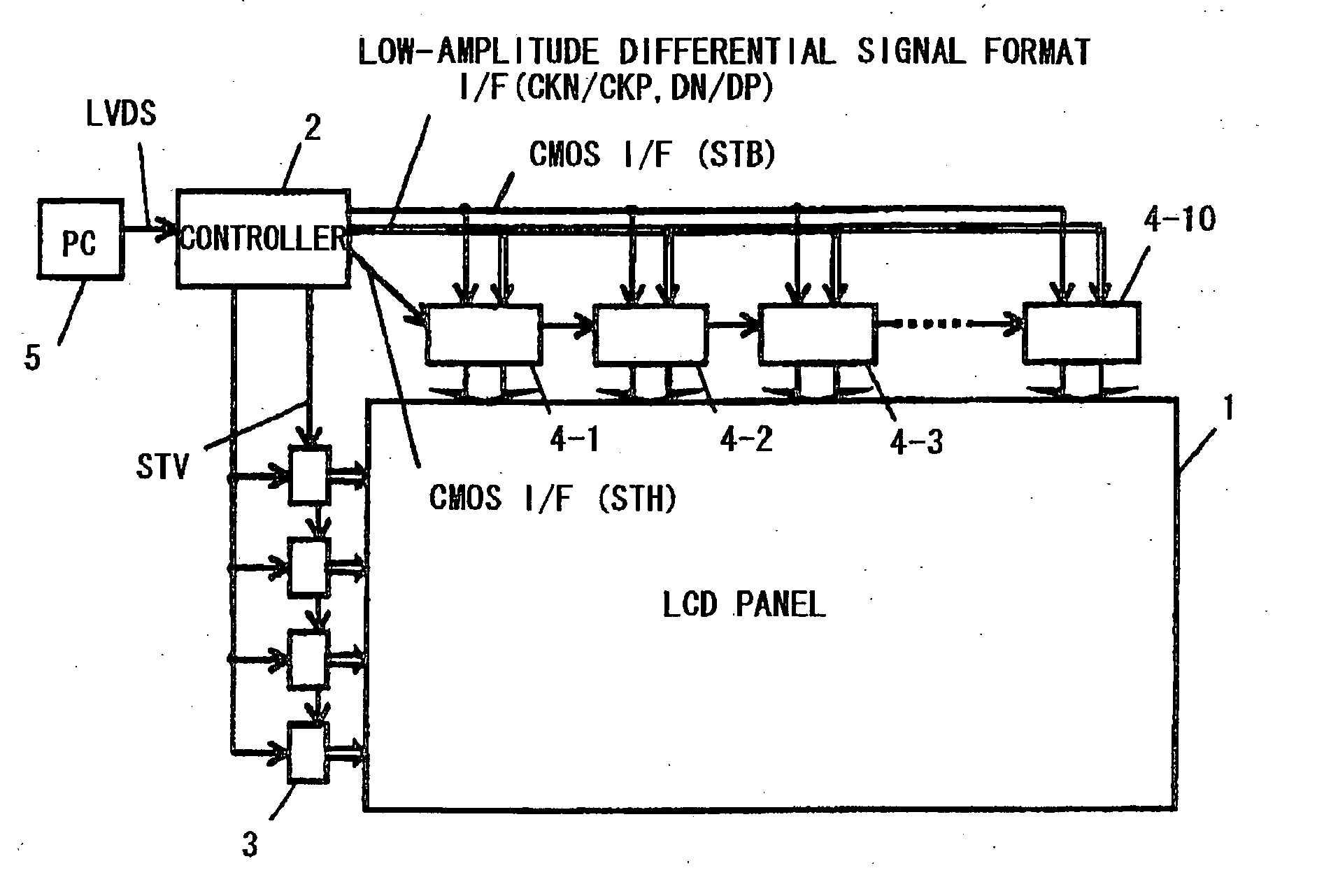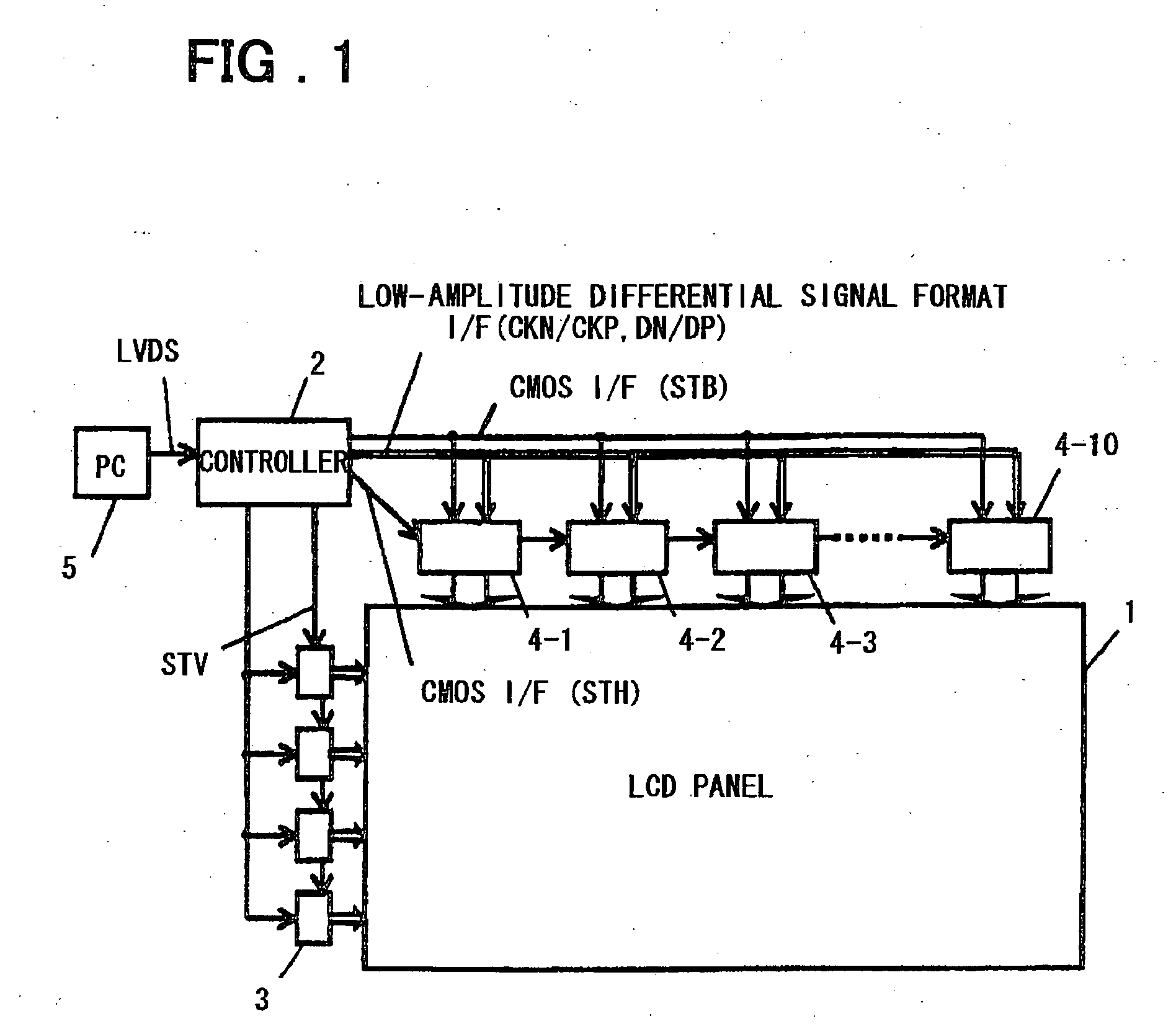Semiconductor integrated circuit device
a technology of integrated circuits and semiconductors, applied in logic circuits, pulse techniques, instruments, etc., can solve the problems of display data not being loaded normally, display data prevailing immediately after, and fluctuation of the potential of bias wiring
- Summary
- Abstract
- Description
- Claims
- Application Information
AI Technical Summary
Benefits of technology
Problems solved by technology
Method used
Image
Examples
first embodiment
[0053] Reference will be had to FIGS. 3 to 6 to describe a receiver 20 of a first embodiment used as the receiver 17. As shown in FIG. 3, the receiver 20 includes a first receiver 21 for a clock signal; a plurality of second receivers 22 for display data; a control signal generating circuit 23 for generating control signals Vc1, Vc2; a plurality of switches 24 for changing over between supply and cut-off of the bias potential to the second receivers 22 depending upon the control signal Vc1; and a bias circuit 25 for supplying a first bias potential Vb1 to the first receiver 21 and a second bias potential Vb2 to the second receivers 22 to cause the first receiver 21 and second receivers 22 to operate. The first bias potential output Vb1 of the bias circuit 25 is led out by first bias wiring 26, and the second bias potential output Vb2 of the bias circuit 25 is led out by second bias wiring 27. The switches 24 correspond to respective ones of the second receivers 22, and the switches ...
second embodiment
[0067] A receiver 30 used as the receiver 17 will be described next with reference to FIGS. 7 to 9. Components identical with those of the receiver 20 shown in FIG. 3 are designated by like reference characters and need not be described again. The receiver 30 in FIG. 7 differs from the receiver 20 of FIG. 3 in that the receiver 30 has a bias circuit 35 instead of the bias circuit 25. Further, the bias circuit 35 differs from the bias circuit 25 in that it has a second bias potential generating circuit 353 instead of the second bias potential generating circuit 253 and further includes a precharging circuit 354 and precharging power supply 355, as shown in FIG. 8.
[0068] The second bias potential generating circuit 353 has a circuit structure, which is similar to that of the first bias potential generating circuit 252, constituted by MOS transistors Q23, Q24 instead of the MOS transistors Q13, Q14 of the first bias potential generating circuit 252 in order to output a steady bias pot...
third embodiment
[0078] A receiver 40 used as the receiver 17 will be described next with reference to FIGS. 10 to 13. Components identical with those of the receivers 20 and 30 shown in FIGS. 3 and 7 are designated by like reference characters and need not be described again. The receiver 40 in FIG. 10 differs from the receiver 20 of FIG. 3 in that the receiver 40 has a control signal generating circuit 43 instead of the control signal generating circuit 23 and a bias circuit 45 instead of the bias circuit 25, and in that a capacitor 46 is connected between ground and the node of the connection between the second bias wiring 27 and each switch 24. The control signal generating circuit 43 differs from the control signal generating circuit 23 in that it does not have the pulse-width adjusting circuit 232, as illustrated in FIG. 11. Further, the bias circuit 45 differs from the bias circuit 25 in that it has the second bias potential generating circuit 353, which is used in the bias circuit 35 of the...
PUM
| Property | Measurement | Unit |
|---|---|---|
| clock frequency | aaaaa | aaaaa |
| bias potentials | aaaaa | aaaaa |
| bias potential | aaaaa | aaaaa |
Abstract
Description
Claims
Application Information
 Login to View More
Login to View More - R&D
- Intellectual Property
- Life Sciences
- Materials
- Tech Scout
- Unparalleled Data Quality
- Higher Quality Content
- 60% Fewer Hallucinations
Browse by: Latest US Patents, China's latest patents, Technical Efficacy Thesaurus, Application Domain, Technology Topic, Popular Technical Reports.
© 2025 PatSnap. All rights reserved.Legal|Privacy policy|Modern Slavery Act Transparency Statement|Sitemap|About US| Contact US: help@patsnap.com



